The occasional Bald Eagle lurks near the west end of the Antelope Island causeway for good reason – lots of potential prey. The open water near the bridge attracts a variety of waterfowl so falcons and eagles are sometimes seen in the area.
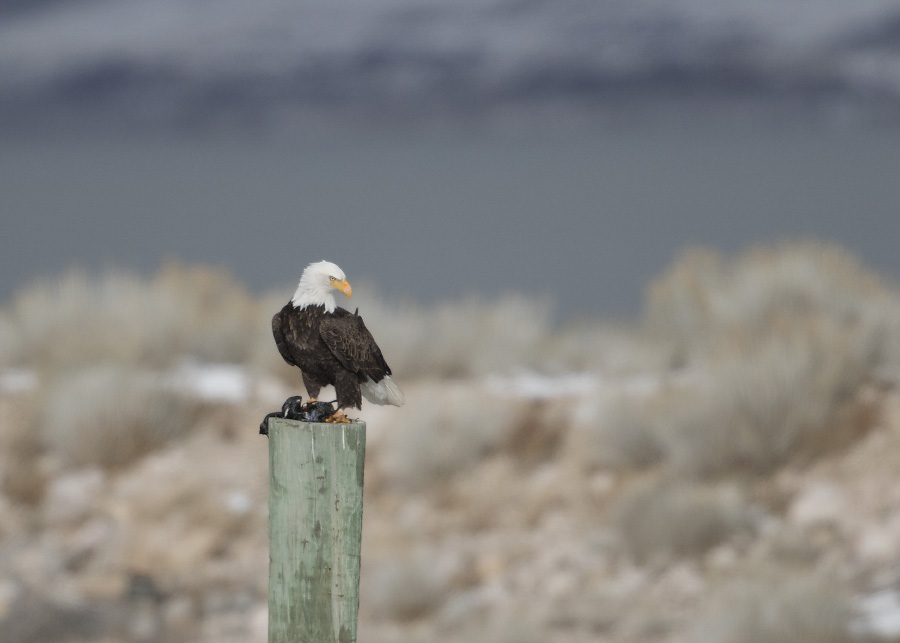
1/4000, f/5.6, ISO 500, Canon 7D Mark II, Canon EF 500mm f/4L IS II USM + 1.4 tc, not baited, set up or called in
Five days ago (Christmas Eve Day) we found this adult Bald Eagle with prey atop one of the poles in the marina as we were leaving the island. I suspect the prey to be an Eared Grebe though I’m not sure of that. The eagle seemed just a little nervous, possibly because of traffic coming on to the island from the causeway and it didn’t take long for it to…
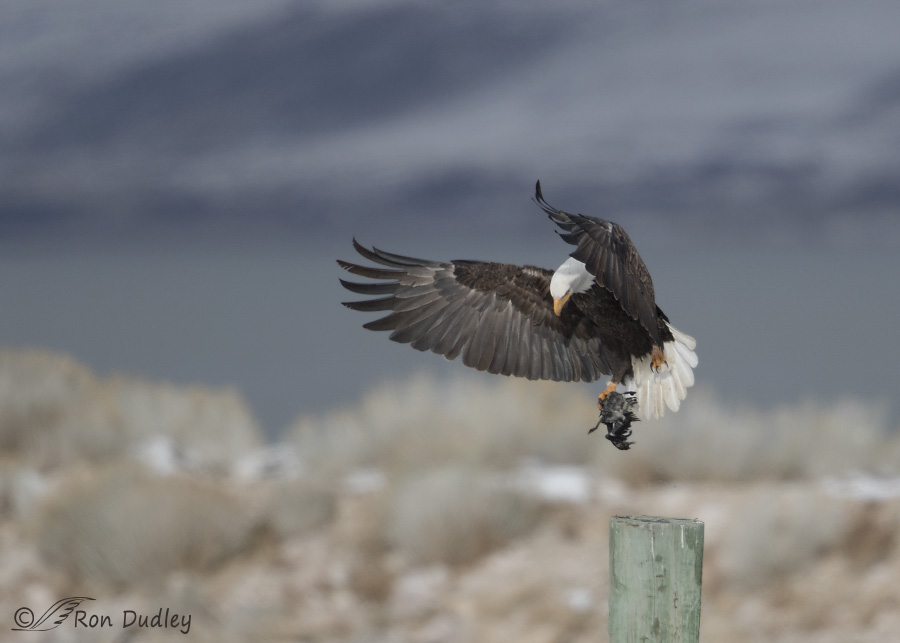
1/4000, f/5.6, ISO 500, Canon 7D Mark II, Canon EF 500mm f/4L IS II USM + 1.4 tc, not baited, set up or called in
take off with its prize.
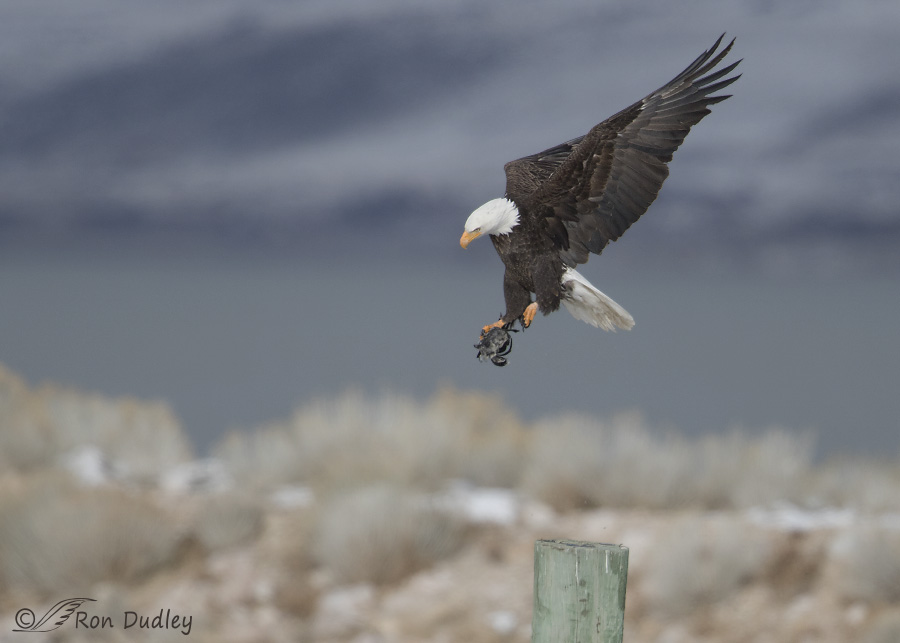
1/4000, f/5.6, ISO 500, Canon 7D Mark II, Canon EF 500mm f/4L IS II USM + 1.4 tc, not baited, set up or called in
The eagle was quite a distance from me but I often fire off a burst in these situations just in case I notice something interesting when I inspect the images more closely later.
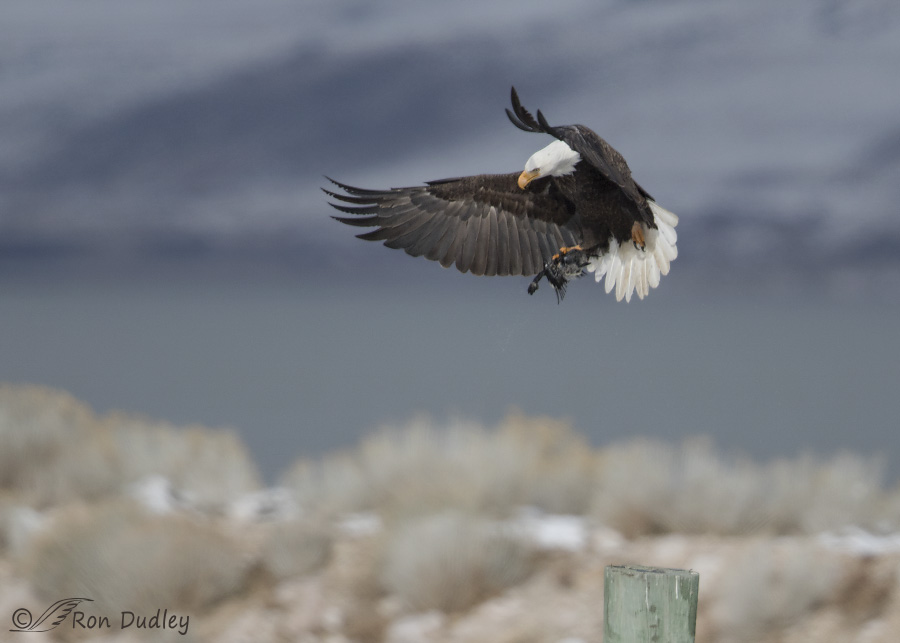
1/4000, f/5.6, ISO 500, Canon 7D Mark II, Canon EF 500mm f/4L IS II USM + 1.4 tc, not baited, set up or called in
I was also hoping it would fly toward me with its prey…
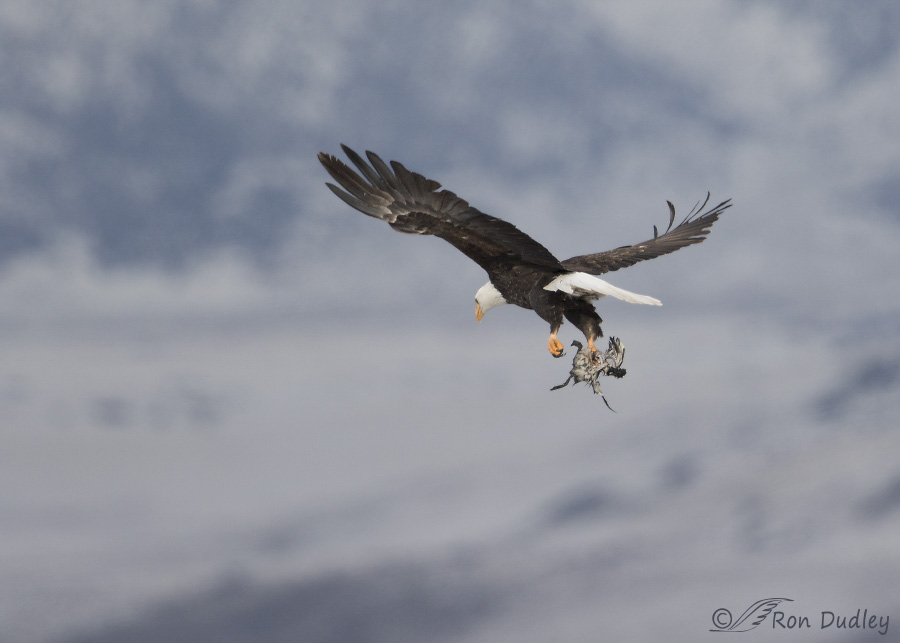
1/4000, f/5.6, ISO 500, Canon 7D Mark II, Canon EF 500mm f/4L IS II USM + 1.4 tc, not baited, set up or called in
but instead it chose to head north in the opposite direction.
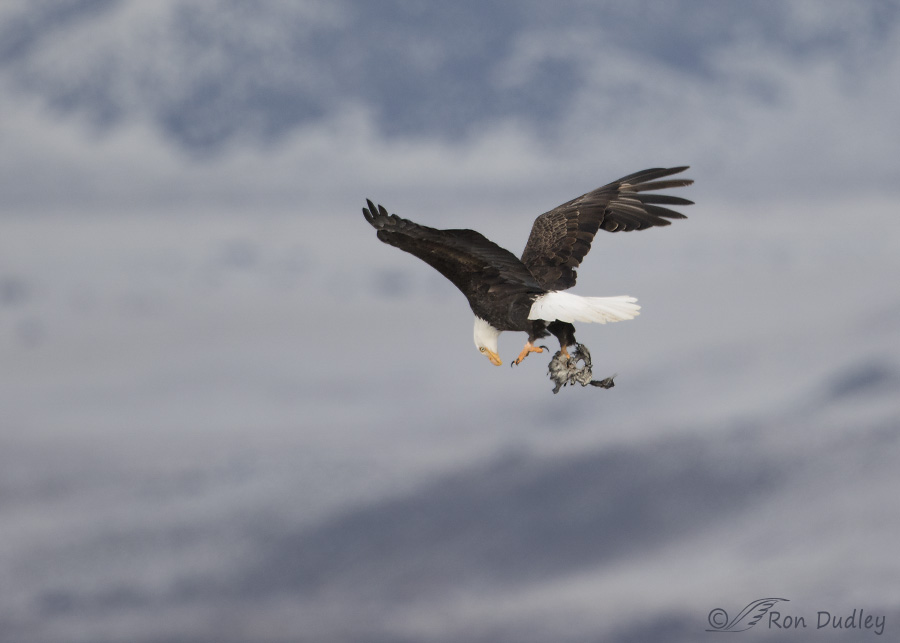
1/4000, f/5.6, ISO 500, Canon 7D Mark II, Canon EF 500mm f/4L IS II USM + 1.4 tc, not baited, set up or called in
At one point it seemed to inspect its prey in flight, almost as if it was checking out its grip on the grebe. Soon after this shot I stopped pressing my shutter button because the eagle was mostly facing away from me and quickly becoming quite small in my viewfinder.
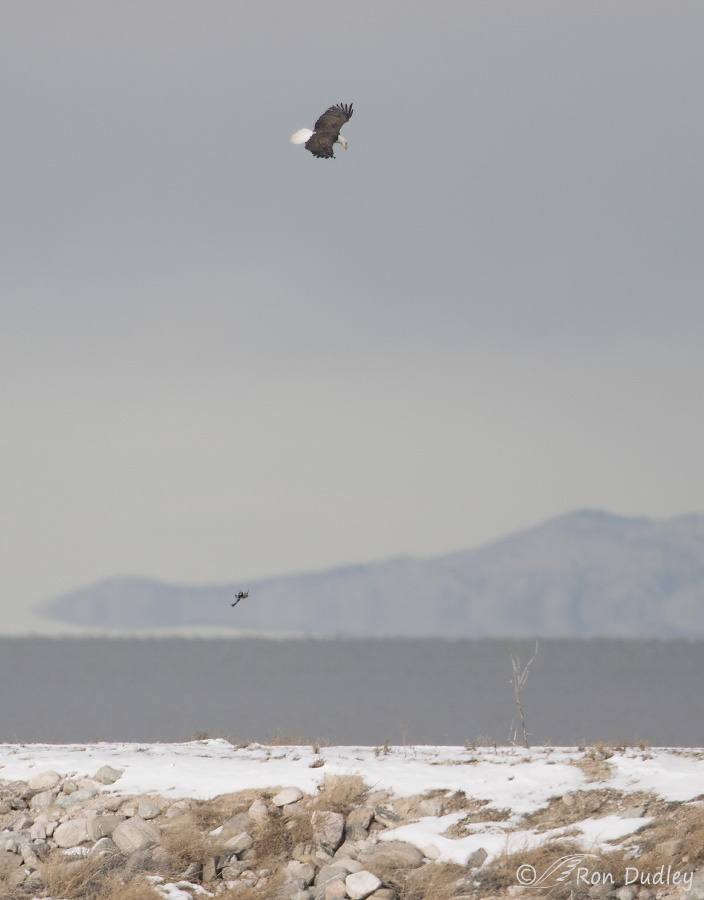
1/4000, f/5.6, ISO 500, Canon 7D Mark II, Canon EF 500mm f/4L IS II USM + 1.4 tc, not baited, set up or called in
But suddenly, when I was just about ready to put my camera down, the eagle dropped its prey.
I have no idea if the grebe was dropped accidentally or on purpose, though I suspect the former because the eagle swooped down and apparently retrieved it. I couldn’t actually see that happen though because the grebe was dropped near the shore where I couldn’t see it.
This prey item looked to be in pretty tough shape so it’s possible that it was scavenged or stolen from another raptor. In the past I’ve witnessed Bald Eagles stealing prey from falcons in this same area.
Ron


Sensational behavioral shots Ron thanks for sharing! !
Charlotte
Judy, I checked your link…these certanly are some unusual shots…wonder if that one woman with the weasel still has lips…
Another great series. I particularly like it checking out the prey – and from the state of it probably wondering whether it would be easier to go to Maccas.
How sad that even a well equipped predator needs to resort to scavenging to survive.
Bald Eagles are well known for their scavenging habits, EC. That’s one of the reasons that Ben Franklin was opposed to the species being our National Bird.
Politicians are the ultimate in bottom feeding scavengers…
You mean to tell me that you have that kind of politico in Australia too, EC? I thought we had that market cornered…
You are so right!!!
Your pictures are always beautiful and your writing exciting!! Thanks!
Thanks, Jane, I appreciate the kind words.
Lovely images Ron. Very crisp. My favorite is when it is checking the prey. I need to increase my shutter speed, I think. Was this a pretty bright day? For eagles I usually have 1/1250 sec, f/7.1 on a 1DX, 5D3, or 7D2 with a 600mm f/4 + 1.4 x. The physicist in me wants to calculate the ideal shutter speed — however that requires some knowledge I do not have of how fast wing tip moves. I think it is more prudent for me to just look at how sharp your images are and copycat you
Ed, it was cloudy with low light all morning but I did get better light for these shots as I was leaving the island.
I’m of the opinion that relatively fast shutter speeds help with more than just fast moving subjects or subject body parts (like flapping wings). They also help with sharpness just because of the nature of a supter-telephoto lens. Long lenses magnify the effect of any camera shake (even with image stabilization) and that effect becomes even more exaggerated the further your subject is away from you. And I wasn’t very close to this eagle. I (nearly) always try to err on the side of too much SS rather than too little if I have that option.
I love the one where the eagle is checking the prey. Just got back on line after our New Mexico blizzard.
Just got back on line after our New Mexico blizzard. 
Thanks, Arwen. That blizzard sounded like a doozy – hope you didn’t have any major problems with it…
We kept power but lost internet. Had plenty of wood and enjoyed the time off actually.
Had plenty of wood and enjoyed the time off actually. 
This is a beautiful series…love the wing positions…wonder if that prey is so badly decomposed that it fell apart where the eagle had its grip.. It looks awfully ragtag…not much to it. Poor eagle! I hope it got it back…and found the effort worth iit…….
Patty, I suspect it retrieved the grebe unless it fell in the water. It dropped close to the shore and the higher bank in front prevented me from seeing what was going on.
Interesting series. I feel badly for the Eagle, losing its prey; I hope it was able to retrieve it. One of the things I will never forget is seeing the youngest of the first batch of Kestrel babies we observed, accidentally drop the prey she received (prior to being able to fly). The expression on her face when she lost it said she knew exactly what it meant that she had dropped it. I would guess that she was about 20 feet above ground in the palm tree where they were raised, so she wasn’t about to get it back. That’s a hard lesson for a youngster to learn.
“That’s a hard lesson for a youngster to learn”
Yes, but in the long run I suspect it’s a lesson that pays off, Susan. But when I think about it it’s a little surprising that I’ve seen raptors drop prey as often as I have. It seems to be a fairly common occurrence.
Sometimes that whole majestic thing just doesn’t work! All of us are clumsy at some point
“All of us are clumsy at some point”
You’ve got that right, Laura. One of my greatest fears is that one day I’ll drop my big lens. That would be catastrophic…
Oh my goodness, Ron!!! A whole series of captures of my favorite Raptor!! I love all you photos today but I especially love #2 and #4 because of this eagles wing positions. They are such gorgeous flyers and seeing the tips of their wings curved up and splayed is wonderful to see. The Wright Brothers studied and learned much about flying by observing the eagles and vultures for hours and days on the sands of Kitty Hawk. I guess that means we owe these marvelous raptors our own flight. (not something YOU enjoy though!! LOL)
I figured you might enjoy this, Jo Ann. Thank you.
Magnificent shots, Ron! Did look like the prey was pretty well worked over by the time the eagle had it. A link to some fun wildlife photo’s – the last picture is how one would NOT want to see an eagle.
Did look like the prey was pretty well worked over by the time the eagle had it. A link to some fun wildlife photo’s – the last picture is how one would NOT want to see an eagle.  http://www.boredpanda.com/nature-photographers-behind-the-scenes/
http://www.boredpanda.com/nature-photographers-behind-the-scenes/
Judy, it may very well be that the grebe was falcon leftovers that were scavenged by the eagle. A variety of other species, including harriers and coyotes, regularly feed on leftovers from Peregrine and Prairie Falcon meals along the causeway.